News and Highlights
This is a list of past iUTAH EPSCoR news from 2012 to 2018.
January 17, 2018
Why Science Communication Matters – Afternoon Workshops in Logan & SLC
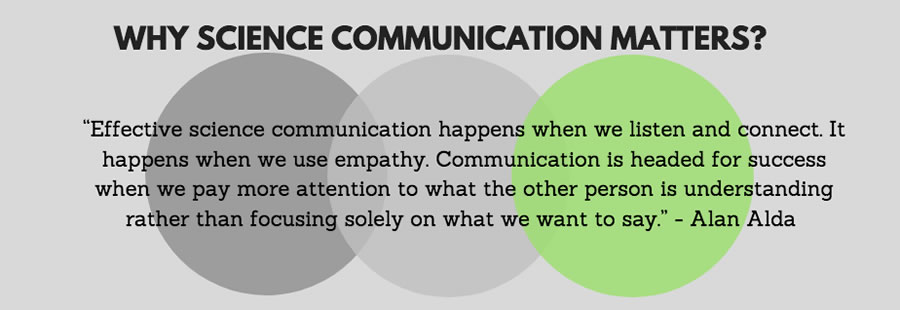
Clear communication can improve understanding, empathy, and respect for the work that scientists do. The public wants to understand, support, and value advancements in science BUT for this to happen, scientists must first engage the public in their work rather than wait for the public to come to them. This workshop will help individuals to reimagine science communication as a proactive rather than reactive effort. Participants will learn to assess their current science communication efforts, build a strategy to reach more people, adapt content using social media and other communication channels, and expand their impact by building an outreach network connected to other programs.
The Why Science Communication Matters workshop was developed as collaboration between iUTAH EPSCoR, the University of Utah’s Office of the Vice President for Research, Utah State University’s Office of Research and Graduate Studies, and USU’s Ecology Center to address this topic. Workshops in both Logan and Salt Lake City will be free and open to education practitioners from across the state.
Researchers, faculty, graduate students, and other practitioners are invited to attend this free workshop that will focus on learning science communication strategies that individuals can apply to meet their professional goals. iUTAH team members Andreas Leidolf, Jeannine Huenemann, and Ellen Eiriksson will present their own experiences and connections forged while working on a $24MM National Science Foundation water research, education, and outreach project in the state, as well as examples of successful, proactive science communication by researchers from across the state.
You should plan to attend if you are looking to build a strategy to communicate your science to non-scientific audiences, create a stronger broader impact approach for grant applications, or connect with outreach groups in your state.
Participants are encouraged to ask questions while learning how to design and implement effective messages to engage with diverse audiences in dynamic and compelling ways. You will leave with ideas and resources on how to approach science communications in a way that best supports your professional goals and objectives. Both workshops, listed below, will cover the same material.
Utah State University campus:
When: Tuesday, February 27, 1 – 4 p.m.
Where: Conference Rm/1st Floor (158/158A), USTAR Bioinnovations Building (IC650), 650 E 1600 N, Logan, UT
University of Utah campus:
When: Thursday, March 1, 1 – 4 p.m.
Where: Eccles Boardroom (Rm. 1850), Warnock Engineering Building (WEB), 72 South Central Campus Dr. Salt Lake City, UT
Cost: Workshop is offered free of charge. Preregistration is encouraged, as space is limited. Walk-up registration on the day of the workshop is also an option, but we cannot guarantee available space.
January 17, 2018
Cross-Campus Collaborations Bring Classrooms Together
One of the hallmarks of the iUTAH project has been collaboration between campuses across the state. Throughout the past five years, researchers have shared ideas, equipment, and even students. This spirit of sharing has led to the development of a number of cross-institutional courses, including ones involving hydroinformatics, watershed planning and management, and green infrastructure.
The Green Infrastructure course was co-taught for the second time around this last fall at Utah State University and the University of Utah. Ryan Dupont, a professor in civil and environmental engineering at USU, had 14 students in his section of the course, while Sarah Hinners, a research assistant professor in city and metropolitan planning at UU, had 12 students, or a total of 26 students.
The class met on Friday afternoons, at their own respective campuses in technology-linked classrooms, exploring the topic of green infrastructure from planning and engineering to homelessness and social equity, and hearing from a variety of guest speakers. Field trips brought the class together to meet in-person to view and discuss local examples of Green Infrastructure planning and execution in the Ogden area. They also ran parallel field trips in Logan and Salt Lake City, and reported back to one another.
When asked about the benefits of bring the course together, Ryan Dupont said that “content and discussions we have had in the joint offering course are richer, than when I am able to offer the course myself with only engineering students making up the class roster. I find it very valuable to have students, faculty and guest lecturers with different perspectives on this subject presenting and discussion issues on GI design and implementation.”
As part of the USU section, students completed a class project to enter EPA's Campus RainWorks Challenge, for which student teams design an innovative green infrastructure project for their campus that effectively manages stormwater pollution while benefitting the campus community and the environment. At UU, four students worked with the Jordan River Commission and a state legislator to produce background research and recommendations for a proposed Jordan River State Park.
Both Dupont and Hinners said that interdisciplinary engagement has been a very positive aspect of their involvement in iUTAH, one that they hope continues into the future. “I don’t have an available co-instructor from engineering down here, and I really can’t cover that topic area well myself, but it’s critical to the topic of green infrastructure,” said Hinners. “I really love having a diversity of backgrounds, experience and expertise in the classroom.”
Other courses brought together by the iUTAH project that use this model of cross-campus collaboration include Integrated River Basin Watershed Planning and Management and Water Resources Planning taught by David Roseberg from USU and Steven Burian from UU. In 2012, a Hydroinformatics graduate course was started taught by Jeff Horsburgh and David Rosenberg from USU, along with Steve Burian from UU, and Dan Ames from BYU. The course was offered simultaneously at the three locations via interactive video conferencing and covered information on how to use computer software and hardware to collect, manage, and analyze large amounts of water-related data. The course has been offered annually since 2012, with a one-time expansion in 2014 to include faculty and students from University of Wyoming, and University of Virginia.
Syllabi for the Fall 2017 Green Infrastructure course:
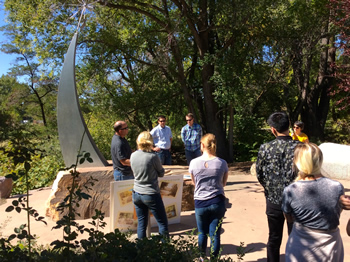
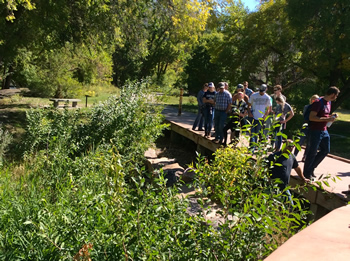
December 20, 2017
WSU Symposium Showcases Student Research
Amid the hectic schedule of finals week, some Weber State University students made time in their busy schedules to present their research findings from participation in iUTAH’s summer iFellows undergraduate research fellowship program and faculty Research Catalyst Grants (RCG). The event was co-hosted by Carla Trentelman, associate professor of Sociology, and Dan Bedford, professor of Geography and WSU honors program director, and attended by students, faculty, administrators, and friends of iUTAH.
This year, two WSU undergraduates, Maggie England and Mike Fowles, were part of a cohort of 15 students that participated in the 11-week summer research experience. During that time, they were actively involved in iUTAH fieldwork, research, and analysis. Working with faculty and student mentors, these students learned about the challenges and solutions needed to sustain the state’s water supply over the next few decades and the environmental impacts that we have on bird species, and aquatic habitats in local watersheds.
Students presenting research at the WSU symposium include Maggie England, Mike Fowles, and Rebekah Holt. Past participant attendees included Cynthia Elliot, 2016 iFellow, William Soule, Summer Institute mentor, and Kassandra Sqrow, who participated in both an RCG and as a Summer Institute mentor.
Rebekah Holt worked with faculty mentor Bridget Hilbig, assistant professor of botany at WSU, on a RCG project focused on enhancing soil complexity to improve sustainable urban agriculture. They constructed a rooftop garden, adding Arbuscular mycorrhizal fungi (AMF) native to Utah to soil and measured growth responses in pepper plants. While the AMF plants grew better, challenges with the location and the growing boxes limited the growth of viable crops. Future research will involve changing the plants from peppers to parsley, and making adjustments to the boxes and watering schedule.
“Ever since iUTAH began, our colleagues at Weber State have been terrific supporters of undergraduate research,” said Mark Brunson, iUTAH Education, Outreach and Diversity director and professor in the Department of Environment & Society at Utah State University. “Our research faculty have greatly enjoyed working with Weber students, and the work they’ve done has made a real contribution.”
In the five years that WSU has partnered with iUTAH, 41 students have been involved in undergraduate research, including 14 iFellows, 7 Summer Research Institute mentors, and 24 student RCG researchers.

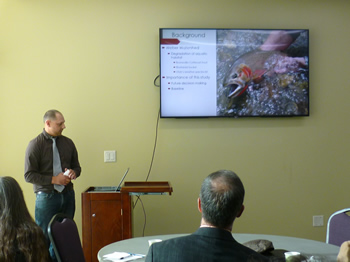
December 4, 2017
Researcher and Team Contribute to Restoration Efforts
iUTAH Education, Outreach and Diversity Director Mark Brunson, professor in the Department of Environment & Society at Utah State University, is contributing to restoration efforts by the Shoshone Nation on the site of the Bear River Massacre near Preston ID.
An excerpt from the Herald Journal writer Sean Dolan said “When Darren Parry was a child, his grandmother took him to the site of the Bear River Massacre. He didn’t quite understand why she always had a tear in her eye she when pointed out where the lodges used to be. As he has grown older and taken on leadership roles in the Northwestern Band of The Shoshone Nation, he now understands how important it is to honor a request she made before passing away five years ago.
Brunson and his team, "after consulting with Parry, [will be} preparing a description of what that restoration might look like. One of the main challenges will be removing the invasive Russian olive trees, which Utah classifies as noxious weeds. Then, Parry and Brunson hope to plant native grasses, shrubs and trees. Part of the process is gathering information on what the land used to look like and what plants are indigenous to that area.
"During his research, Brunson said he came across a map drawn by a soldier led by Col. Patrick Connor that included several willow thickets around the Bear River. Willows are no longer found in that area, which Brunson said could be due to the river shifting and cattle grazing. Parry said willows were vital to the Shoshone people. ‘They used the willows as protection from the weather, and they made things out of it,’ he said. The willows were just one aspect that made that valley an ideal winter camp. Parry said the largest natural spring in the county is nearby, and there are several natural hot springs around the river.”
Brunson said that a team, including Molly Cannon, director of the Museum of Anthropology, Eugene Schupp, professor in the Department of Wildland Resources, and Matt Munson, an undergrad researcher, all from USU, are conducting assessments and preparing a proposal to develop a restoration plan.
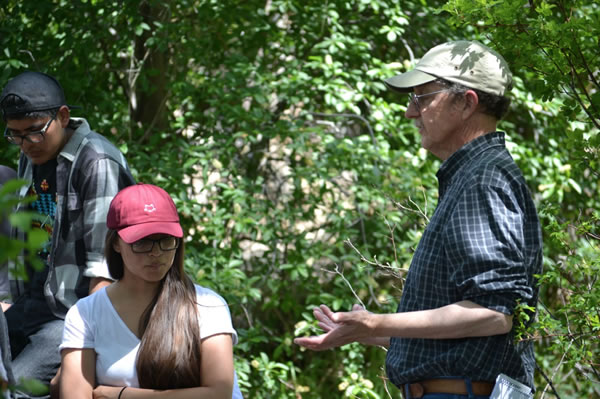
November 28, 2017
In the Balance: Communication Flow
iUTAH and Utah State University researchers Bethany Neilson, an associate professor in Civil and Environmental Engineering Departments, and graduate student Julie Kelso were included in USU’s Winter 2017 alumni magazine. The article “In the Balance” features Neilson, Kelso, and other scientists, each grappling with how to adjust and mitigate water solutions for the future.
An excerpt from the story by John DeVilbiss tells of Julie’s journey from water researcher to water communicator this way. “After years of monitoring water quality on the rivers of Logan, Provo, Red Butte, and Jordan, Kelso says she now finds herself trying to communicate it to others in a meaningful way. It has been both eye opening and a bit maddening. ‘I think that’s where I get frustrated with research because, at the end of the day, it may not matter how much research you do, or answer scientific questions, if people’s values fundamentally are driving the policy-making decisions.’ So how do you communicate research to influence public values and subsequently public policy? It is a new frontier for Kelso. She is already honing her communication skills as a science reporter for Utah Public Radio. Anything to help start the conversation and bring people together. She is convinced that collaboration across universities and communities is essential if we hope to manage water more wisely.
"She thinks the biggest impact of her research with iUTAH was the way so many people came together to look at the question of water sustainability for Utah’s future. It was not just research and social scientists; they managed to get people of all labels across the state, in all different disciplines, and not just involving USU, but all three primary research institutions in the state. ‘We’re trying to get away from scientists in ivy towers working by themselves, which I think will be extremely hard to overcome,’ she says.”

November 21, 2017
Growing a Water-Wise Citizenry
Part of iUTAH’s aim is to provide learning opportunities and foster experiences that promote water education for students of all ages. We have worked with our museum partners to create both stationary installations and traveling exhibits reaching well over 400,000 people at 412 public outreach events in the past five years. This number is still growing since many of these displays are still in active use.


